A $200 suit and a $2,000 suit are certainly not the same: obviously, there’s an $1800 gap! But the question is, is it worth the difference? What are the hallmarks of a $200 suit versus a $2,000 suit? And should you care? We’ll walk you through all aspects of them so you get the perfect suit for your money.
$200 Suit: What Are The Sacrifices?
So, right out off the bat, what kind of sacrifices do you have to make with a $200 suit? Frankly, at this price point, you must make sacrifices in terms of quality. There’s no way around that. But why is that, you might think?
Well, there are certain fixed costs. You have the material, you have things like shipping, the infrastructure like a shop or an online storefront, and the people that are involved. You won’t be able to get a custom suit at that price point, unless you go to a really low labor-cost country like India for example.
In order to get to the $200 price point; you have to accept cheaper materials that won’t age as well; you have to accept a fused interlining that will be less comfortable and will make you more hot when you wear it.
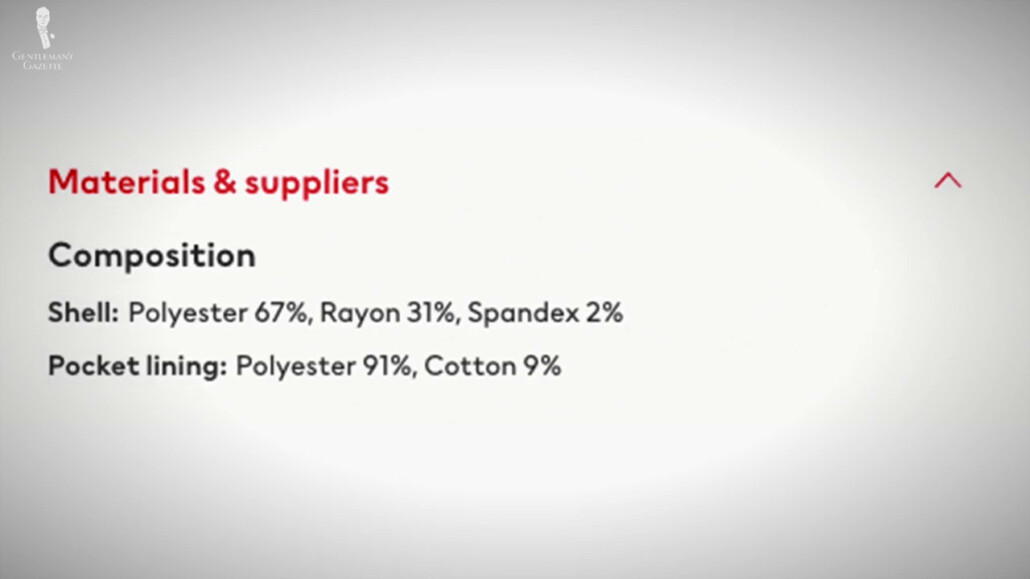
Keeping costs minimal often requires sacrificing quality.
Some brands even offer $200 suits: Jos. A. Bank, Men’s Wearhouse, or H&M; they’re joined by mall brands like Perry Ellis, Calvin Klein, or Lauren by Ralph Lauren.
But, hey, does it get even cheaper? Yes! Places like Target, Walmart, and sometimes Primark offer suits in the $100 range.
A few years back, a retail price of $1,000 bought you much more in quality, but with inflation and increased material and labor costs, you now have to pay more to get something that’s really worth your money. Of course, this only applies to retail price. If you want to learn how you can make your dollar spread further in buying vintage clothes, check out our other guide.

Just because the suit brand is expensive, it doesn’t mean it delivers quality.
Brands like Brooks Brothers or Hugo Boss now have suits in the thousand-plus dollar range, but you don’t quite get the quality that that price once commanded.
Brooks Brothers: Their History & A Brand Evaluation
$2,000 Suit: What Do You Get?
Obviously, there are ready-to-wear brands offering suits at this price point. Think of Ralph Lauren, Caruso, Cifonelli, Drake’s, Belvest, Corneliani, Paul Stewart, N. Peal, Canali, and so forth. In general, suits from these brands will have higher quality overall, but not every suit is worth its price tag. So, if you want to know which ready-to-wear suit brand offers the biggest bang for your buck, check out our ranking post, where we stack up 54 ready-to-wear suit brands against each other.
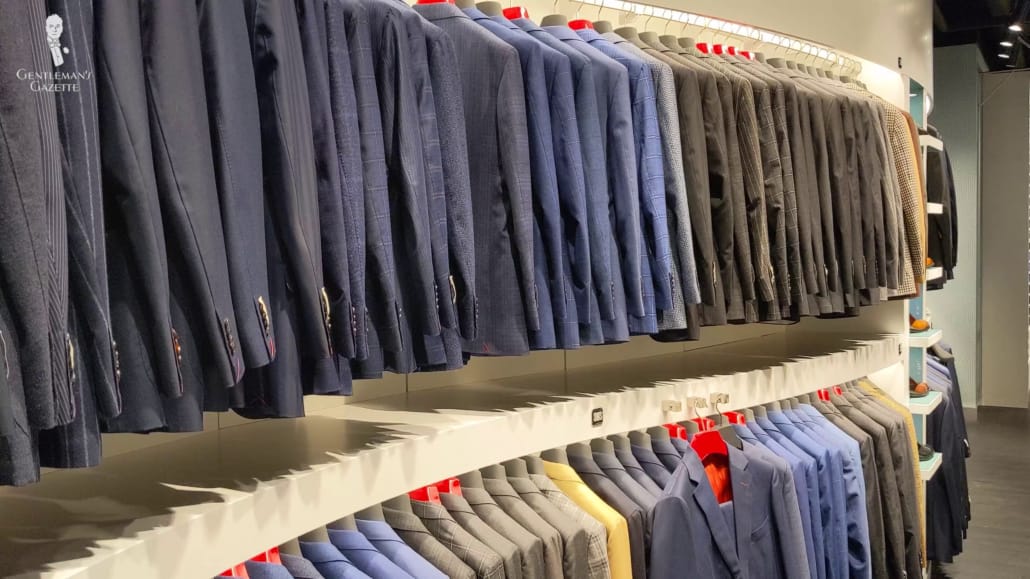
By considering the points mentioned in this article, you can help ready-to-wear suits fit you well.
Now, the nice part about a $2,000 price point is that you do not have to go ready-to-wear; you can go made-to-measure, and in some instances, you’re even able to go into bespoke territory. That means you get the fabric you want, you get the styling you want, you get the details you want, and all that with a fit that is hopefully superior to that of a ready-to-wear suit.
Keep in mind that the terms “custom,” “made-to-measure,” or “bespoke” are not protected terms, so, buyer beware! If you want to understand the differences, our separate guide has covered.
At this price point, there are many options available online. You can also find local options. And if you’re, for instance, in Italy, you may find a local master tailor who will maybe make you a suit for $2,000 if you bring your own fabric. No, $2,000 won’t buy you the best suit in the world, made from the most expensive fabrics with the most elaborate handwork, but you will get something that is good, that will stand the test of time, and that’s comfortable to wear.
Just because a suit is custom or made-to-measure doesn’t mean it is made at a higher standard than a ready-to-wear suit, and there are instances where a ready-to-wear suit can be made to a much higher quality standard than a so-called custom suit. That’s why it pays to watch the Gentleman’s Gazette, so you can identify if custom clothing is a myth or not and what to look for so you don’t get scammed.

Isaia suits are known for their exceptional quality and attention to detail.
Lastly, you could also take your $2,000 and invest it in formerly really expensive suits from Kiton, Brioni, Isaia, and so forth at a much-reduced price. Frankly, though, if you’re open to the secondhand market, you can find suits of that caliber for under $1,000 on places like eBay. So, if you spend $2,000, we strongly suggest you go the made-to-measure or custom route.
Keep in mind that name brands can always command a higher price for the same quality product as a lesser brand. Ultimately, you have to decide what is worth it to you and what isn’t. That’s why our “Is It Worth It?” series exists: to determine which brands are worth their high price and which aren’t.
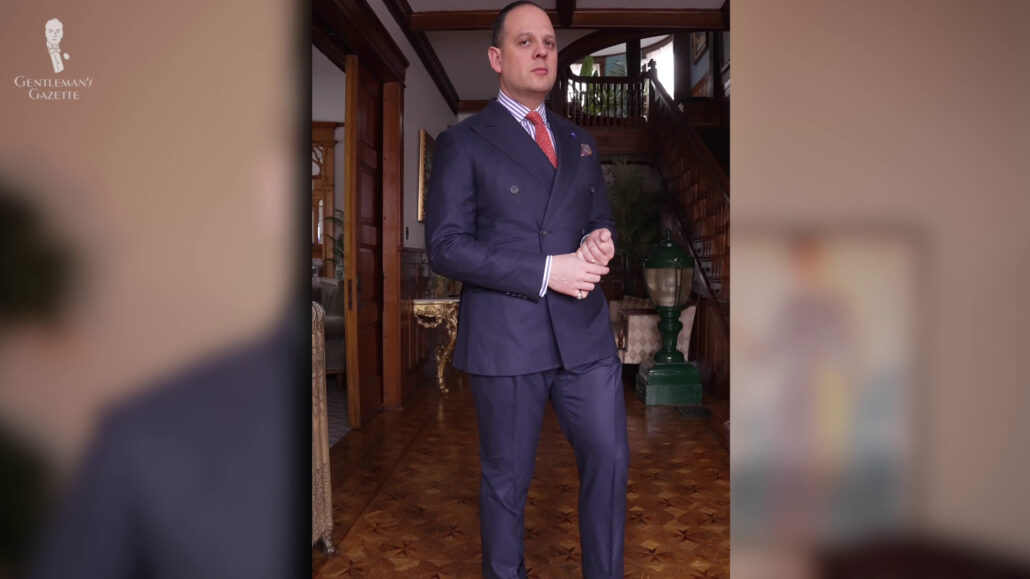
Raphael’s suit that’s made of extremely fine wool from Vitale Barberis Canonico.

Fort Belvedere
Dark Blue Mini Delphinium Boutonniere Buttonhole Flower
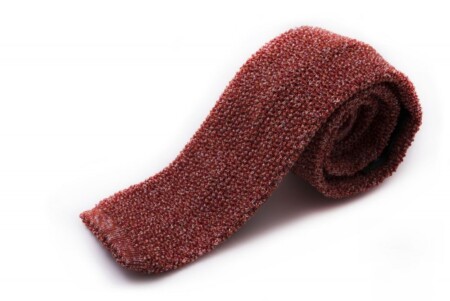
Fort Belvedere
Orange Red Mottled Knit Tie Cri De La Soie Silk
$2,000 Suit vs. $200 Suit
How They’re Made
In terms of assembly, you’ll only have about two to three manhours that can go into sewing a $200 suit. The work will be done entirely by machine without any handwork.
We’re not saying that all machine work is bad. In general, machines are good, and even for suits, for example, on a lapel, using a Strobel machine is the way to go because it’s much more cost-efficient. However, there are areas where having a bit of handwork is nice because the seam is more flexible and, therefore, more comfortable to wear.
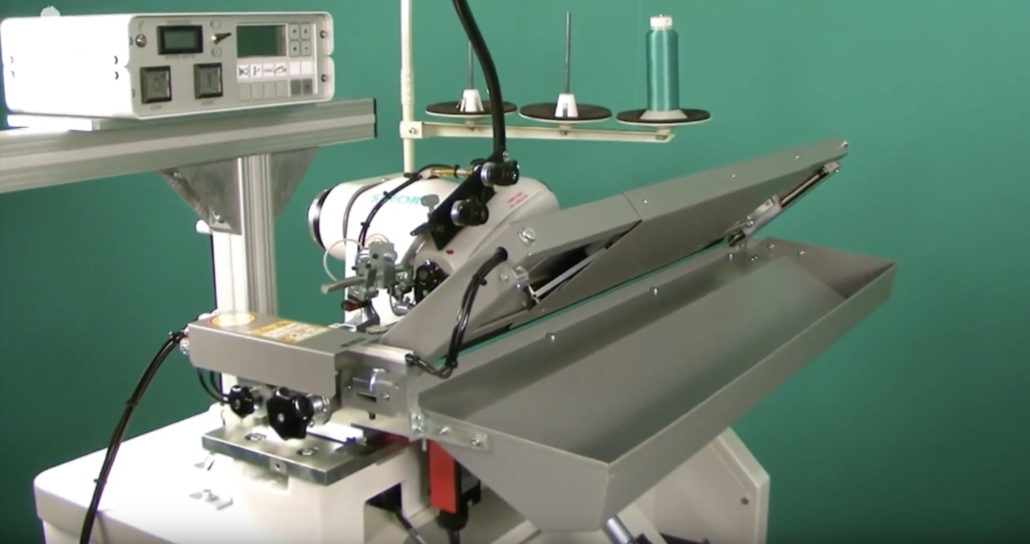
Strobel machine
For example, in a $200 suit, the sleeve is sewn on all in one step. So, you have the lining, you have the outer shell fabric, and you have the shoulder petting, and it’s all put strobelin together and sewn together, so it’s less flexible and less comfortable. If you can afford to do these steps separately, it takes longer, and it’s more expensive, but you will feel it when you wear the jacket.
Pattern & Fit
Typically, in a $200 suit, you will get very simplified patterns. Usually single-breasted, with one lapel shape, maybe two buttons, with no extra details – no half-back belt, no pleats, etc. The pants may have a flat front, or maybe they have one pleat. It is all decided for you with nothing to choose.
The rise will typically be low, which is less flattering for most body types, and if you have big thighs or big calves, that really won’t help you because those types of suits typically can’t accommodate you.
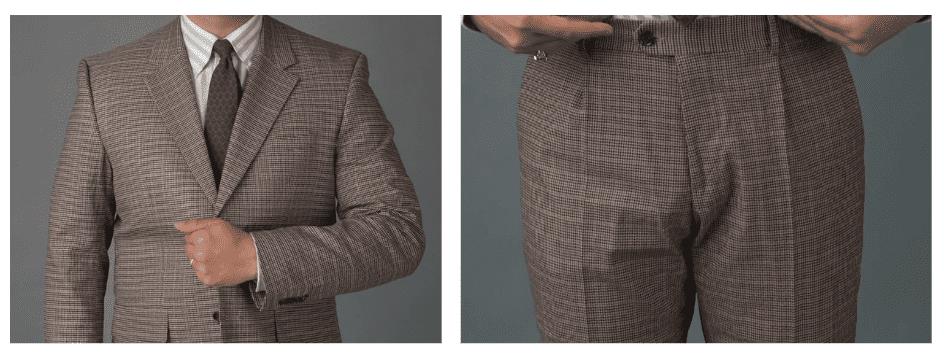
Surprisingly, the $200 H&M suit fits Raphael well.
That being said, I was positively surprised to see a $200 H&M suit in regular fit actually fit me rather well. In fact, it fits me better than many other much more expensive garments, but that was just lucky in that case: my body just happens to suit their cut well. Typically, I can hardly ever wear the pants of a suit, but here, I could, although they were purchased as separates, so I did not have to take the trousers with the regular drop. My H&M jacket is a 44 regular (US), and my pants are 38 regular (US).
Another apparent issue that we’ll find in most $200 suits is that their upper sleeves are quite tight. So when you reach forward, when you wave for a cab, or if you move your arms, you will feel much more constricted. This problem is amplified if there is not enough drape of your shoulder blades in the back because it makes you feel constricted in the front on your sleeves but also in your back, making the whole suit uncomfortable to wear.

Most $200 suits has upper sleeves that are quite tight that feels more constricted.
The $200 H&M suit had somewhat tighter upper sleeves than the $2,000 suit because you couldn’t customize it to my personal preferences, but it wasn’t as bad as other garments I’ve tested and worn in the past that were ready-to-wear in that price range. Because of the restrictions in a $200 jacket, you typically also see much more of a collar gap due to the cheaper and easier-to-execute way that it is assembled. Honestly, in this H&M jacket, though, it’s not that bad.
Compare that to the $2,000 jacket. I mean, there’s less gapping on a $2,000 jacket, but a $200 does just fine, especially compared to other ready-to-wear jackets.

Raphael gets collar gaps in many RTW jackets.
If you’re new to suits, you may not know how to distinguish between machine stitching and hand stitching. Typically, you can look under the collar, and you’ll see if it was attached by hand, which means irregular stitches or if it was machine sewn with great regular stitches.
By the way, we have a post about the quality hallmarks of a suit that walks you through step-by-step on how you can identify a quality suit from a crappy one.
In a $2,000 suit, there’s typically more handwork. Overall, between 8 and 30 hours will go into a suit. If you want to buy a made-in-the-USA suit, you will get less handwork and fewer manhours in a suit of comparable quality to something that was made in China, for example.
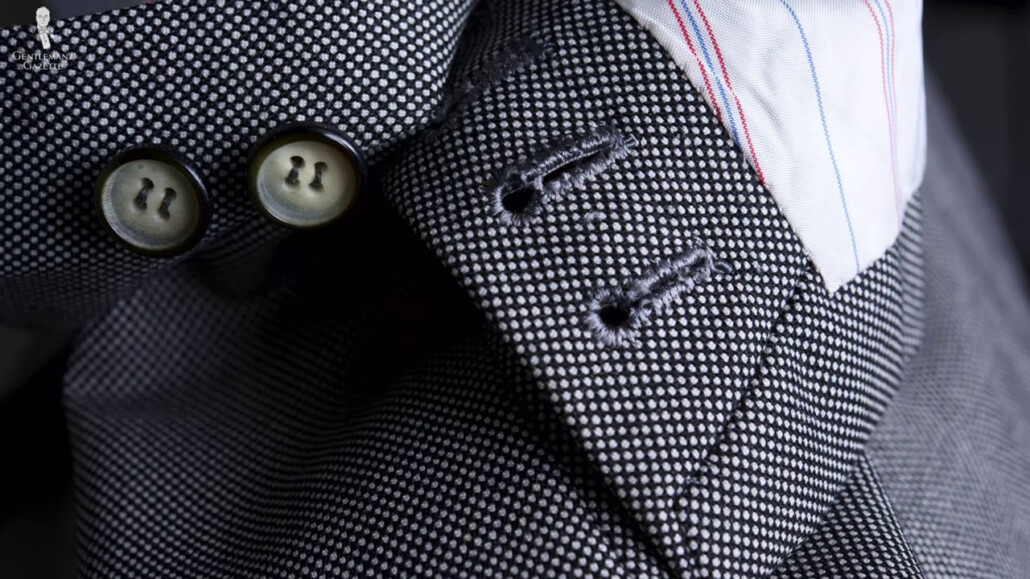
handwork handstitched
Here, I’m wearing a $2,000 made-to-measure suit that was made from Harrisons of Edenborough flannel fabric, and it has a very similar houndstooth pattern to the H&M one.
If you look at the collar or the sleeve lining or inside the jacket on the sleeves and how they’re sewn in, you can see the handwork. Also, if you compare things like the buttonholes, for example, you see a clear difference between the $200 and a $2,000 suit. The $200 suit is machine-made and not even fully opened. The $2000 suit is handmade with a nice silk thread and is beautiful.

Raphael can customize and add some pleats for extra volume in the $2,000 suit.
With the $2,000 suit, I could customize what I wanted. So, I wanted some shooting pleats on the side, I wanted a half belt, and if you look at my patch pockets, they have a little pleat for extra volume when I put things in my pockets, but also for a stylistic element. I also chose a three-roll-two silhouette; with a $200 suit, you’re more likely to get just a single two-button suit.
Also, in a $2,000 suit, I can choose to go with a matching vest, which will be hard with a suit from H&M at $200. Maybe you’re lucky if you have a matching vest, but more often than not, they don’t have that kind of stuff.
Fabric
The $200 suit has an outer fabric shell that is made of 67% polyester, 31% viscose, and 2% elastane. That elastane helps to make everything more comfortable to wear, and when I first touched the suit, I was positively surprised because it felt rather soft. I could tell the $200 suit wasn’t cashmere, like from Kiton, which is always super luxuriously soft, but still, it felt pretty good.
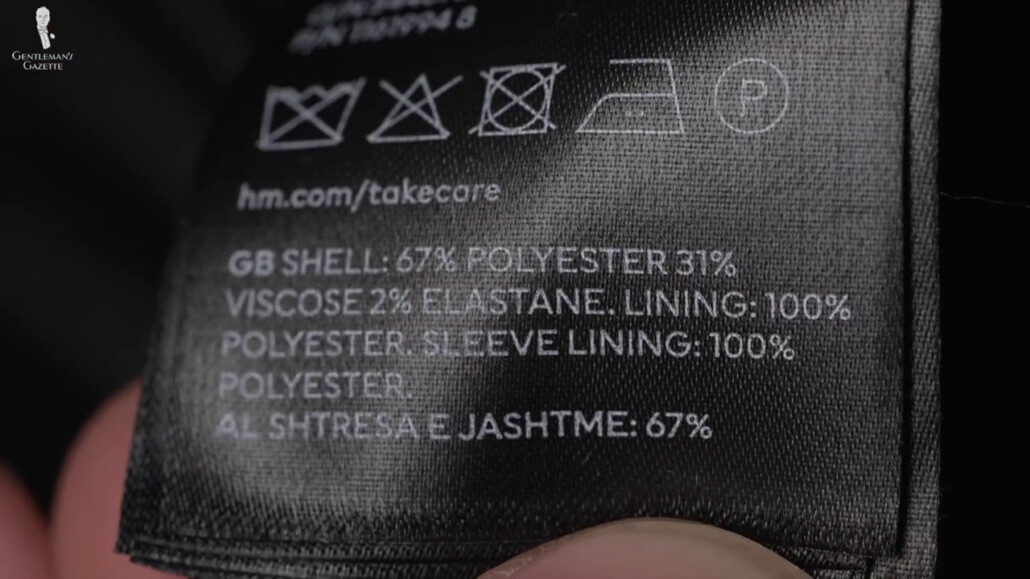
Fabric label of a $200 suit.
The $2000 suit is made from a fabric from a renowned mill called Harrisons. It is a really nice wool-flannel, made of 100% wool that has a nice touch and is perfect for a more casual suit, like the one I chose.
For the lining and sleeve lining, I think the $200 suit has polyester, which is a very cheap option that will also make you overheat more easily. The $2000 suit has a Bemberg lining in a nice changeant color; meaning depending on how the light falls on the fabric, you see a different color, which is very sophisticated. Bemberg or Cupro is, in our opinion, the best suit lining.
Bemberg Lining Fabric
- It’s Anti Static
- Breathable
- Colorfast
- Smooth
- Durable
For a $200 suit, I would have expected a worse, more unpleasant handling of the outer fabric, I would have expected less freedom of movement, and I would have expected it to be a lot hotter.
For this H&M suit, it wears hotter than the 100% wool suit. It is not very constricting, though, and the hand is nice. Of course, the material composition – it being polyester and viscose blended with elastane – will age a lot more poorly and wear out prematurely compared to the wool suit of the $2,000 one.
Keep in mind, when you look at the label and it says it’s 100% something, you can often add 1% or 2% of elastane, for example, without having to disclose that. Reputable brands like Loro Piana or Harrisons or Scabal and so forth won’t do that; what’s on the label will be what’s in the fabric, and when you get a $2,000 suit, you typically have a brand name fabric where you can rely on the label.
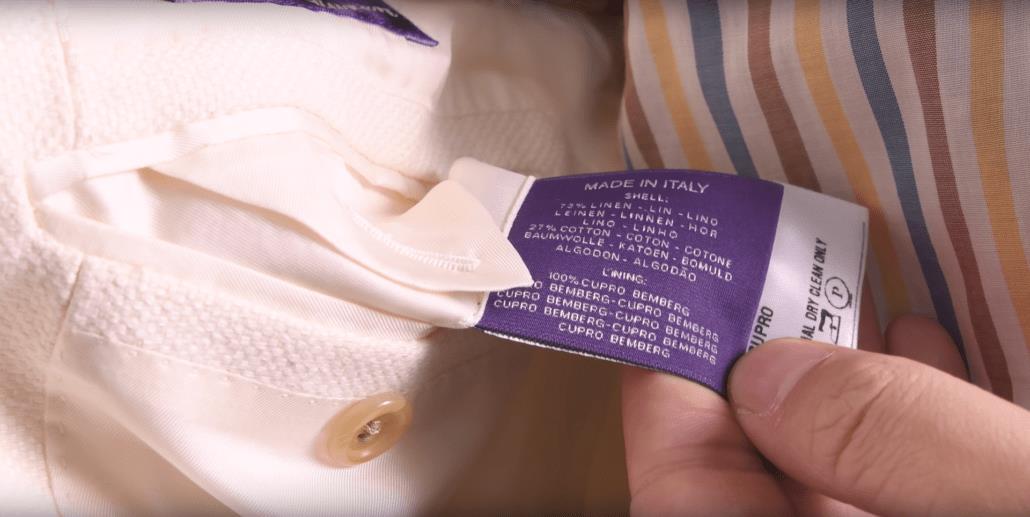
Material Label
On many $2,000 suits, you will find not just the manufacturer’s label but also the maker of the fabric. Why? Well, they’re proud to display the quality maker of the fabric. On an H&M suit, you will rarely find that. That being said, just because one fabric is made at one mill, under one label name, doesn’t mean it has the same quality as something something else that was made at the same mill.
When it comes to fabric, keep in mind that having a certain label like Vitale Barberis, Canonico, or Holland & Sherry will guarantee you a certain minimum quality level that is pretty high, but it doesn’t mean all the fabrics from Holland & Sherry are the same.
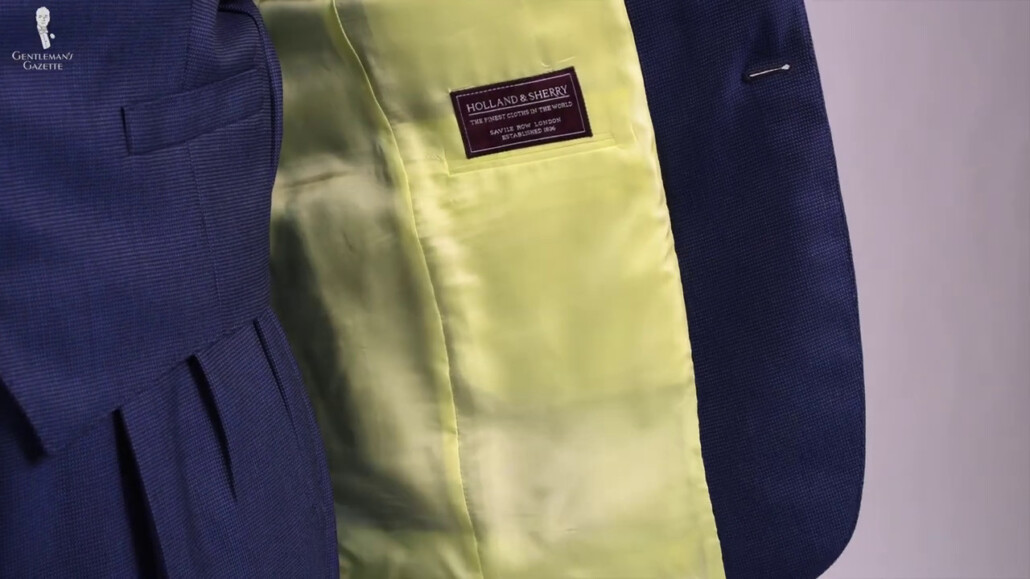
fabric maker label
Because you need about 2 and a half to 3 meters of fabric to make a suit, you will never find a quality cloth label in a $200 suit. Why? Well, the fabric would cost more than the retail price of that suit. Yes, it is true you can buy relatively good fabric in bulk, even from renowned mills, and get a huge discount compared to a cut length that you have to buy in a $2,000 suit.
What does that mean? If you mass produce a suit, you can get one fabric for, let’s say, $50. That would cost $200 or more if you just bought one length for one made-to-measure suit. This is also the reason why most made-to-measure companies advertise their starting price, which may be $800 or $1,000. But you will only see maybe 20 options out there because that’s the fabric that they stock; everything else they have to buy in small quantities at a much higher price.
So, if $2,000 is too much for you and you’re just starting out, maybe try to go with some of the stock fabrics to save you some money so you can still get the same level of workmanship. When it comes to any suit, fit is king, and we’ll show you in another guide on how a suit should fit.
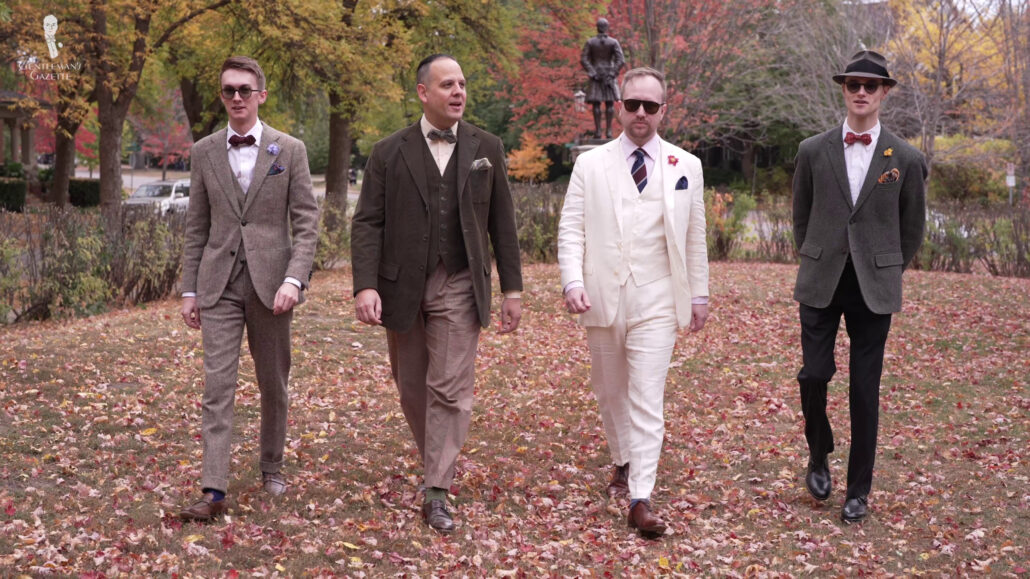
As we always mention every time, fit is king!
In a nutshell, you have to budget for alterations when you buy the $200 suit versus in a $2,000 made-to-measure suit that is all included. Now, a $2,000 suit will have much more of a fabric reserve, thus allowing you to make alterations and make things bigger. A $200 suit will be cut on a minimal pattern with hardly any excess fabric, so all you can do is make the garment tighter or smaller.
Construction
Another huge difference between a $200 and a $2,000 suit is the construction or the interlining used in the suit.
Why do you need it? Well, basically, when you start, the fabric is two-dimensional and flat. Your body is three-dimensional, and so, in order for the fabric to cover you three-dimensionally, you need a second layer of fabric that keeps the outer shell in place so it drapes nicely around your body. If you want to learn more about it, we have a dedicated guide for it.
Interlining
Interlining — another layer of fabric that helps the entire garment maintain its shape, especially around structured portions.
In a $200 suit, this interlining is a layer that is glued onto the outer shelf fabric so it keeps its shape. This is very cost-effective, but it also is uncomfortable because it limits your movement and can make you overheat when you wear it.
Personally, I run hot, so I hate a suit that makes me sweat more than I have to.
Also, over time, that glued interlining is more likely to come off, and sometimes you can see little bubbles and wrinkles on your suit, especially if you wear them hard or if you wear them in the rain. So, the $200 suit will look unsightly much more quickly, and you’ll have to throw it. There’s no way to fix or repair an interlining that is coming off.

Bubbling of a fused interlining due to delamination.
Also, it usually doesn’t conform as well to the body. That being said, on this $200 suit, I felt it fit me rather well for a suit at this price point. Once I put on the $2,000 jacket, though, I could totally feel the difference, which may be hard for you to see, but you have to trust me on that one.
In a $2,000 suit, you will typically either find a half-canvas construction or a full-canvas construction.
What is canvas? They’re typically layers of horsehair, cotton, or wool that provide that shape to the outer fabric. What are the advantages of a floating canvas that is made of natural materials? Well, on the one hand, it breathes, and it’s more flexible, so it moves with your body, thus creating comfort, and you won’t overheat as much. Also, the jacket drapes more nicely and is more flattering.

In a $2,000 suit, you will get either half canvas vs full canvas construction.
The suit I’m wearing today, which was custom-made for me, has a fully floating canvas. I would have to cut open the suit to show you what this one looks like. But we’ve done it before, so you can see the stitch pattern. It’s typically done by a Strobel machine, which is a German machine, and there’s one for the left lapel, for the right lapel, and it cuts down the process of what may take 10 or 20 hours to just a few minutes.
On a $200 suit, the glued interlining will typically also lead to a less flattering lapel roll. Compare it to the $2,000 suit, where you have a nice lapel roll. It’s a little detail, but connoisseurs really appreciate it.
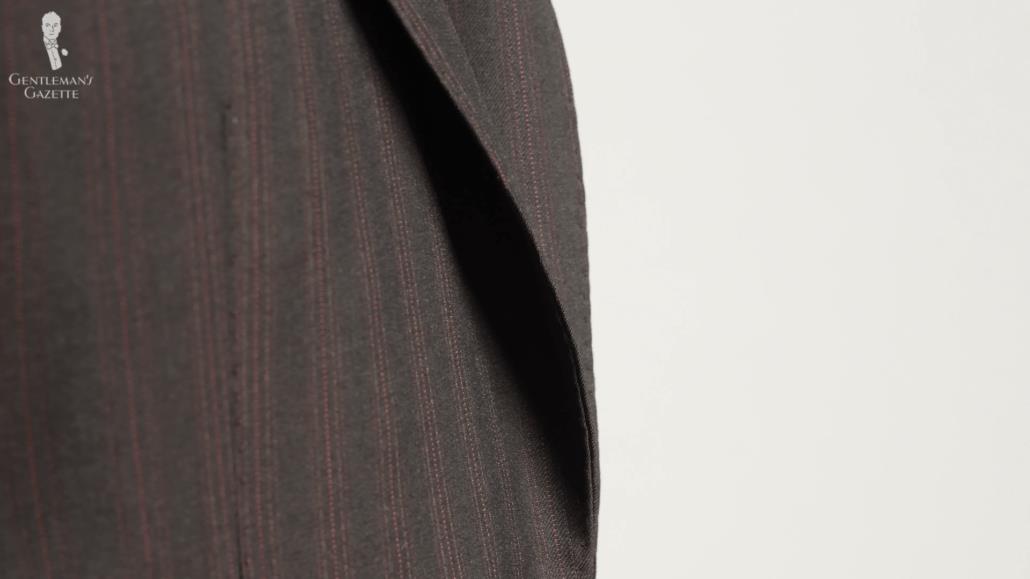
Side view of an excellent lapel roll
The Suit Pattern
When it comes to the pattern, there is usually quite a bit of a difference between a $200 suit and a $2,000 suit. The $200 suit typically comes in very standard regular patterns that are often boxy with a bigger armhole, so they accommodate a large number of people.
The made-to-measure $2,000 suit, on the other hand, can take a pattern, adapt it to your body, and adjust the height of the armhole, making sure it’s as comfortable as it can be for you. Another thing to consider is the front-to-back balance when you look at your suit from the side. The $200 suit will typically have a jacket that is longer in the front and shorter in the back.
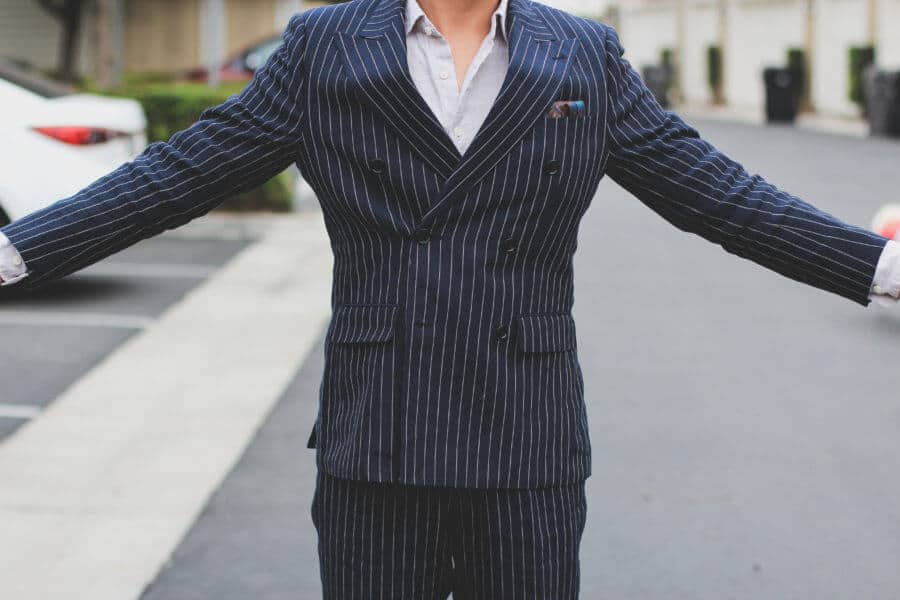
Big armholes restrict movement
$2,000 made-to-measure suits may also have that issue unless there is a good fitter who understands all the implications and can shorten the jacket and create a more level look. Typically, the $200 suit is also more subject to fashion. You may get skinnier lapels than a $2,000 suit, or you may also get a shorter jacket than a $2,000 suit.
So, at the end of the day, a person who really knows how to fit someone in made-to-measure can yield a result that’s much more pleasing than a ready-to-wear jacket can. Even if you have a good alterations tailor, they won’t work all their magic and create something that is as comfortable as the $2,000 suit.
Extra Details
When it comes to details, the $2,000 suit definitely has an edge over the $200 suit.
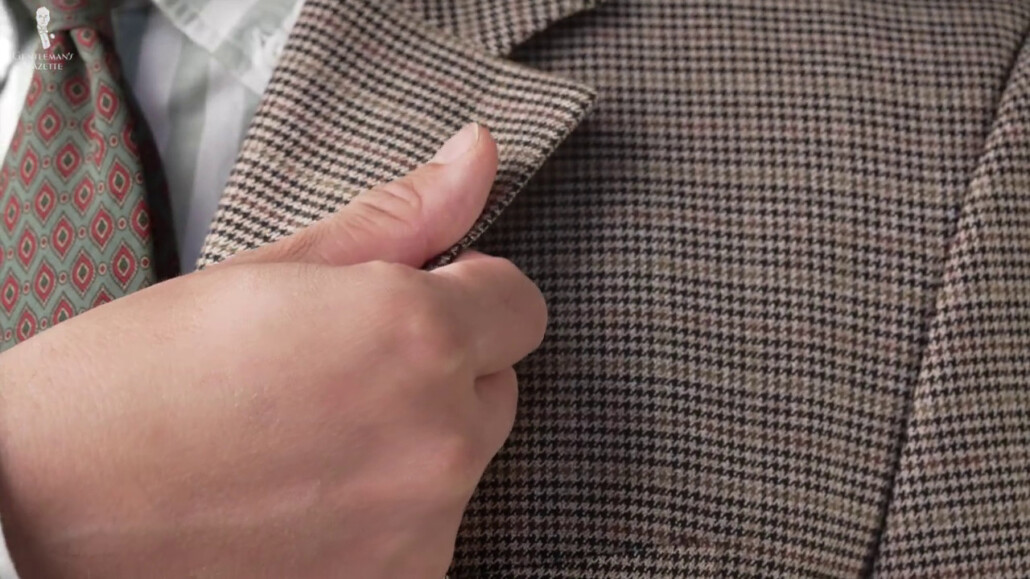
No lapel buttonhole
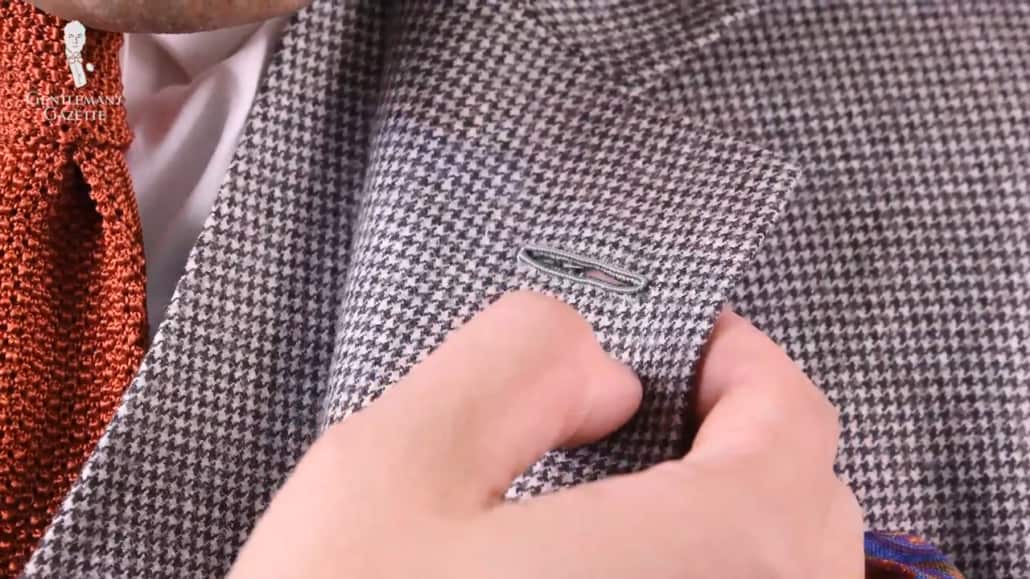
Milanese buttonholes on a lapel
Here, the $200 suit doesn’t even have a lapel buttonhole, whereas the $2,000 suit has a handmade Milanese buttonhole that is raised and elegant. Also, if you look at the other buttonholes on a $200 suit, you can see that they are sewn first and then cut. That is much faster to achieve. It’s also much less expensive, but it’s not as beautiful as a buttonhole that was cut first and then sewn.
When it comes to trimmings – which are the threads, the buttons, and the linings – the $200 suit goes with the cheapest possible thing, which typically is some form of polyester, some artificial material that is maybe made to look like a natural material like horn or corozo.
The $2,000 suit will have nice materials – typically horn buttons, corozo buttons, mother-of-pearl buttons, leather buttons, or even wood buttons.
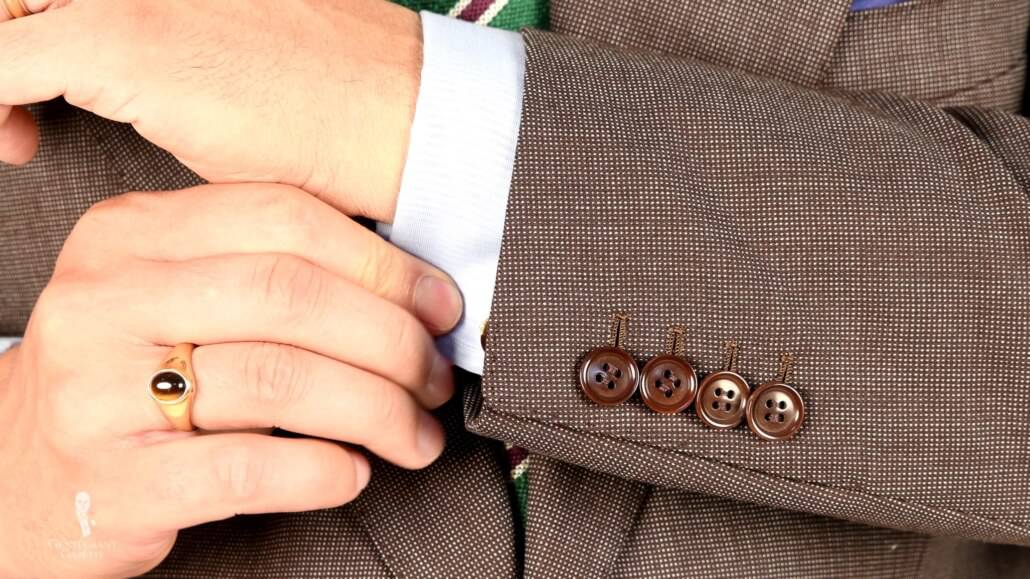
Corozo buttons have the advantage that they can be dyed in any color and thus harmonize with suits very well.
Depending on the style of your suit, you’ll also have details such as pick stitching, which may be done by hand or by an AMF machine, which you may or may not find on a $200 suit. On a $2,000 suit, you can also influence the details when you go made-to-measure. For example, here, I chose to have three sleeve buttons instead of four, and I also wanted a wider gap so I could have a more vintage feel, which was in line with the fabric and the stylistic choices I made in the back of the jacket.
Learn more about buttons!
If you bought a $200 suit in the early 2000s, chances were that you had a very thick shoulder pad and if you moved your arms in combination with a big armhole, it made you look like a football player.
In recent years, that has changed a little bit. Now, even the H&M suit has very little shoulder padding. Now, if you compare it to the $2,000 suit, actually, the $2,000 suit may have a little more, but the materials of the shoulder pad are of higher quality than that in a $200 suit.

Shoulder padding has been a longtime standard within tailoring, offering jacket structure and support across the shoulders and sleeves.
Why does it matter? Well, on a $200 suit, it would likely wrinkle over time, and it won’t keep the shape as nicely as on the $2,000 suit.
Conclusion
In a nutshell, there is a reason why a $2,000 suit costs ten times as much as a $200 suit. Over time, you’ll be more comfortable in a $2,000 suit, it will flatter you more, and it will likely fit you better than a $200 suit.
If $200 is your max budget, I suggest you look into the pre-owned section. That way, you can get a garment that is more in the $2000 range at your $200 price point, so you don’t have to sacrifice the quality at the budget that works for you.
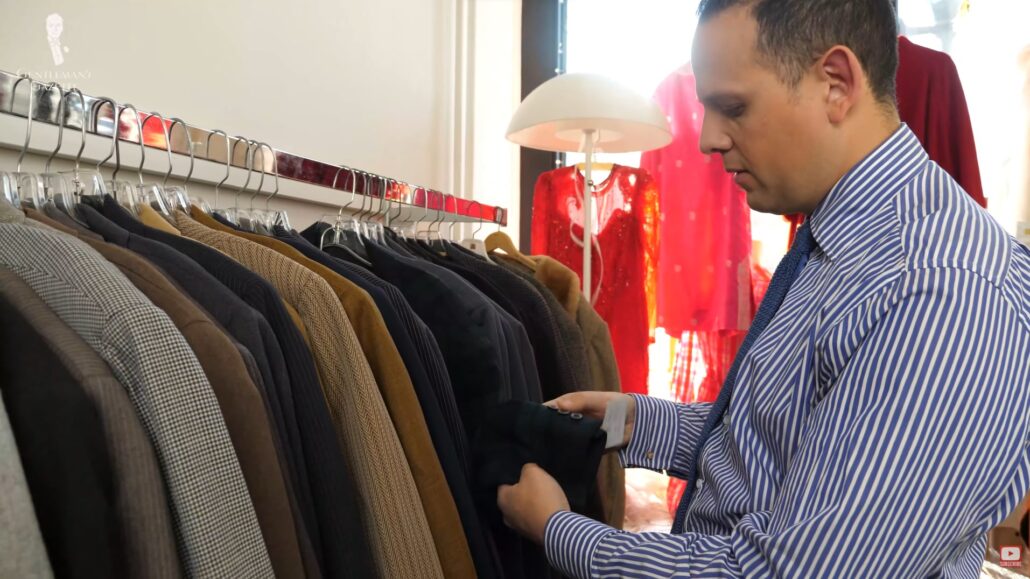
We here at Gentleman’s Gazette are huge fans of buying vintage, pre-owned clothing.
That being said, I was positively surprised about this H&M suit. I had done no alterations, and this is how it fit me. So, overall, I’m impressed with what kind of fit and feel you can get for $200. However, I’m well aware that this thing won’t last for very long, and it won’t age gracefully.
The $2,000 suit, on the other hand, I’ve had for several years. I can tell there may be some areas where they have gotten a little tighter, so either I have to hit the gym harder, or I have to have to visit my alterations tailor. But I know I can do some alterations and make things bigger versus, on the $200 suit, I couldn’t do that.
Outfit Rundown
Today, I’m wearing a three-piece suit from Hemrajani. It has beautiful patch pockets with nice detailing. It has shoulder pleats and a half-belted back. It has this beautiful chocolate brown and off-white color.
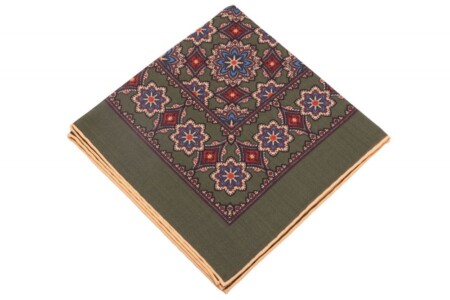
Fort Belvedere
Moss Green Silk Wool Pocket Square with Printed Geometric Medallions in blue, red, black with Eggshell Contrast Edge
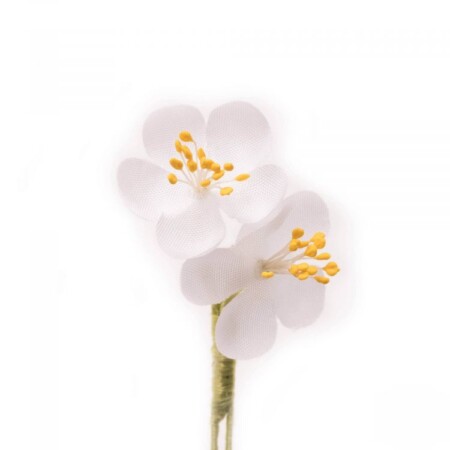
Fort Belvedere
White Cherry Blossoms Boutonniere Lapel Flower
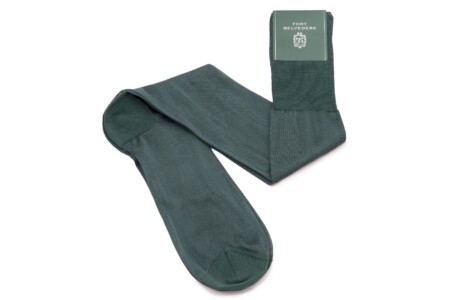
Fort Belvedere
Finest Socks In The World – Over The Calf in Bottle Green Silk
I’m pairing it with a shirt from Spier & Mackay that is green and white-striped, a no-name, green silk tie, as well as a green, wool-silk pocket square from Fort Belvedere, which you can find in our shop, just like this light, pinkish, cherry blossom silk boutonniere.
My socks are solid, bottle green silk socks also from Fort Belvedere, and on my feet, I’m wearing a pair of Chelsea boots in chocolate brown suede from Loake 1880.
On my pinky, I have a nice ring that I found at a flea market in Berlin. It’s a green tourmaline with an art nouveau-style setting in yellow gold.
In line with the fall-winter mood of my outfit and the green elements, I chose the Green Irish Treat cologne from Creed for today’s outfit.
https://www.gentlemansgazette.com/200-dollar-suit-vs-2000-difference/
 Backyard GrillingWeekend WarriorsAdvice from DadBeard GroomingTV Shows for Guys4x4 Off-Road CarsMens FashionSports NewsAncient Archeology World NewsPrivacy PolicyTerms And Conditions
Backyard GrillingWeekend WarriorsAdvice from DadBeard GroomingTV Shows for Guys4x4 Off-Road CarsMens FashionSports NewsAncient Archeology World NewsPrivacy PolicyTerms And Conditions
